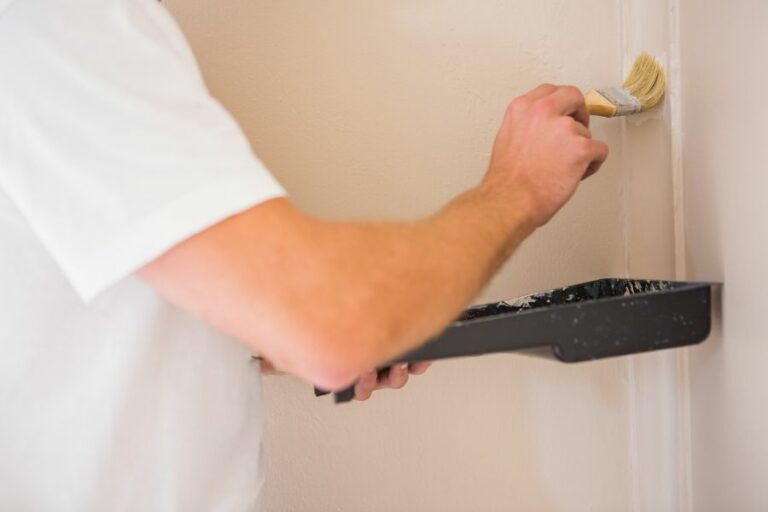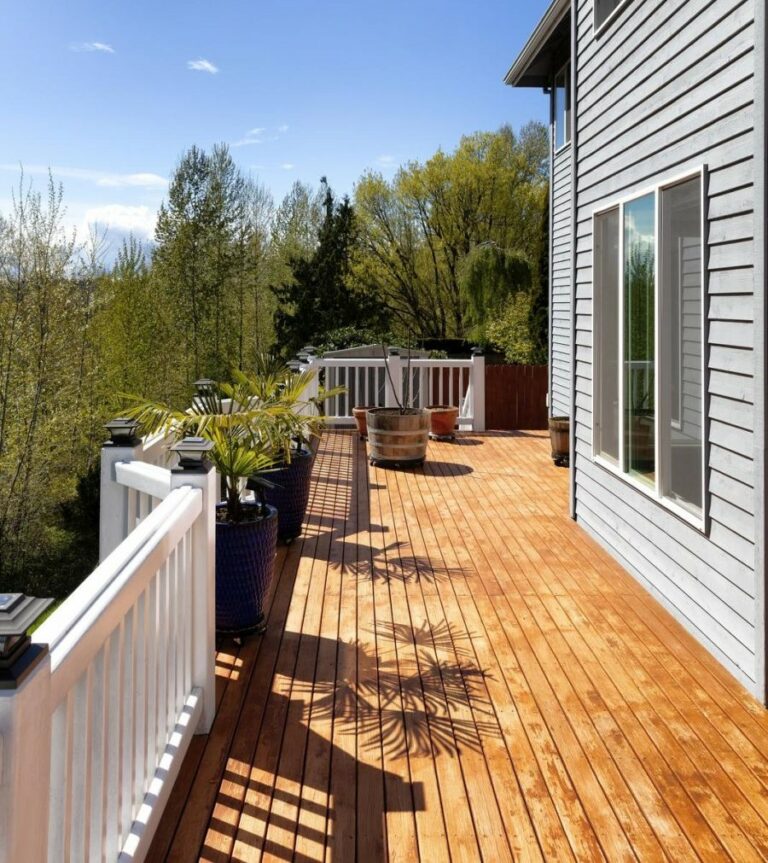Outdoor Stair Paint, 25 Things You Should Know
Outdoor stair paint can transform your old, dull steps while ensuring durability and safety. In this post, we will explore the best paint options for your outdoor stairs, providing you with the information needed to revive your exterior steps for both function and curb appeal.
Outdoor stair paint:
Painting outdoor stairs enhances their appearance and lifespan and requires choosing the right durable, weather-resistant paint, such as acrylic latex or epoxy. Proper surface preparation, including cleaning, sanding, and filling, is crucial for a successful paint job. Apply primer before painting, use at least two paint coats, and perform regular maintenance, including cleaning and inspection, to prolong the paint job’s life.

Discover the perfect outdoor stair paint for your home with expert tips and top product recommendations. Turn your stairs into a stylish focal point, ensuring their durability, longevity, and slip resistance. Let’s embark on this transformative journey together, step by step!
Contents
- 1 Exterior Staircase Paint
- 2 What Type of Paint Should Be Utilized for Outdoor Staircases?
- 3 What is the Most Suitable Paint Type for Exterior Stair Risers?
- 4 What is the Optimal Exterior Paint Choice for Wooden Staircases?
- 5 Identifying the Optimal Paint Choice for Front Porch Steps
Exterior Staircase Paint
Painting outdoor stairs can be a great way to freshen up the exterior appearance of your property. When done properly, it enhances the aesthetic appeal of your stairs and increases their lifespan by protecting them against the elements.
• Choosing the Right Paint for Outdoor Stairs
The first step in painting your stairs is to select the right paint. You want something that is durable, weather-resistant, and non-slip. Here are a few recommendations from our experience:
– Acrylic Latex Paint
This water-based paint dries quickly and is easy to clean up. It provides a smooth surface, is highly durable, and is suitable for both wood and concrete surfaces. Acrylic latex paint is typically available in satin, semi-gloss, or gloss sheens.
– Epoxy Paint
These are two-component paints that provide a highly durable and weather-resistant finish. Epoxy paints are suitable for interior and exterior surfaces and excellent for high-traffic areas. They generally come in high-gloss finishes.
– Non-Slip Paint
This type of paint has a gritty texture that helps prevent slips and falls. Non-slip paint can be used on both wood and concrete surfaces and is ideal for use on outdoor stairs. Some acrylic latex and epoxy paints also come with the option to add non-slip additives.
• Preparing the Surface for Painting
Before you apply any paint on your outdoor stairs, it is crucial to clean and prepare the surface thoroughly. Failing to do so can result in poor adhesion and premature paint failure. Follow these steps to ensure your stairs are ready for painting:
– Cleaning
The first step in preparing your stairs for painting is to clean the surface. Use a stiff brush or broom and a mild detergent solution to scrub away any dirt, algae, or mildew.
If you encounter any stubborn stains or rust, you may need to use a wire brush or a commercial cleaning product designed for these issues. Finally, rinse the surface with a garden hose and let it dry completely.
– Sanding and Filling
For wooden stairs, you will need to sand the surface using medium-grit sandpaper. This will help to smooth out any rough spots and provide a better surface for the paint to adhere to.
For concrete stairs, use a masonry scraper or wire brush to remove any loose or flaking paint and repair any cracks or holes with a concrete patching compound.
• Applying the Paint
It’s time to paint once your outdoor stairs are clean and properly prepared. Here are the steps you should follow to achieve a high-quality, long-lasting finish:
– Priming
Start by applying a coat of primer designed for your specific surface (wood or concrete). Primer promotes better paint adhesion, seals the surface, and ensures a uniform finish.
In most cases, one coat of primer is sufficient, but if you are covering a dark color or there is significant staining, you may need to apply a second coat.
– Painting
After the primer has dried, it’s time to apply the paint. Stir the paint thoroughly before applying, and use an angled brush to apply paint to any edges, corners, and hard-to-reach areas. Use a small roller to ensure even coverage for the rest of the surface.
Apply at least two coats of paint, allowing ample drying time between coats as per the manufacturer’s recommendations. If using non-slip paint, be sure to mix the paint and additive evenly to ensure a consistent texture.
– Finishing Touches
Once the paint has fully dried, carefully inspect the stairs for any missed spots or uneven areas. Touch up as necessary and allow the paint to dry for at least 24 hours before using the stairs.
• Maintaining Your Painted Outdoor Stairs
To keep your outdoor stairs looking fresh and prolong the life of your paint job, follow these simple maintenance tips:
- Clean your stairs regularly with a soft broom or brush to remove dirt and debris.
- Inspect the stairs every few months for any signs of deterioration, such as peeling paint or cracks, and address those issues promptly.
- Reapply a fresh coat of paint or sealer every 3-5 years, depending on the wear and tear on your stairs.
In conclusion, painting your outdoor stairs can significantly enhance their appearance and prolong their lifespan. By selecting the right paint, properly preparing the surface, and applying the paint in a consistent manner, you can achieve excellent results that will last for years.
Regular cleaning and maintenance will ensure that your newly painted stairs continue to look their best and provide a safe, non-slip surface for your family and guests.
What Type of Paint Should Be Utilized for Outdoor Staircases?
Outdoor stairs need special care and attention when it comes to choosing the right paint. Picking the right type of paint will ensure durability, longevity, and a better appearance for your stairs.
• Water-Based Paints: Pros and Cons
Pros:
- Water-based paints have low VOCs (volatile organic compounds), making them environmentally friendly and less harmful to inhale.
- These paints dry relatively quickly compared to oil-based options.
- Paints in this category are generally easy to clean up since only water is required.
Cons:
- Water-based paints are not always as durable as their oil-based counterparts, which means they may need to be repainted more often.
- These paints may be affected by water and humidity levels, leading to potential peeling and chipping.
– Acrylic Latex Paint
Acrylic latex paint is a popular choice for outdoor stairs because it offers durability and resistance to extreme weather conditions. It also adheres well to different surfaces, including wood, metal, and concrete. This paint type is also easy to clean up and will typically dry in a couple of hours.
– Recommendations
My recommendation for acrylic latex paint would be the Behr Premium Porch & Patio Floor Paint. It dries to a low-luster enamel finish, which provides excellent durability against outdoor elements.
• Oil-Based Paints: Pros and Cons
Pros:
- Oil-based paints offer better durability and adhesion than water-based options.
- These paints are less likely to peel and chip due to their resistance to moisture.
Cons:
- Oil-based paints emit higher VOCs, making them less environmentally friendly and potentially causing respiratory issues.
- The drying time for oil-based paints is longer compared to water-based alternatives.
- Clean-up requires the use of chemicals like paint thinner.
– Alkyd Paint
Alkyd paint is a popular choice for outdoor stairs due to its resistance to harsh conditions, durability, and ability to resist peeling and chipping. This type of paint works well on wood, metal, and concrete surfaces, although adhesion is often better on wood.
– Recommendations
My recommendation for an alkyd paint is the Benjamin Moore Insl-x 1 Gal. Sure Step Acrylic Anti-Slip Coating. The paint offers an excellent level of durability, is weather-resistant, and contains anti-slip properties.
• Preparing Your Outdoor Stairs for Painting
Before applying any type of paint to your outdoor stairs, following a few key steps is crucial to ensure the best possible results.
– Clean the Stairs Thoroughly
Before painting, clean the stairs to remove any dirt, debris, or existing paint. This process may require the use of a wire brush, sandpaper, or even a power washer in some cases. Ensure the stairs are dry before moving on to the next step.
– Apply a Primer
Primer helps the paint adhere better to the surface, increasing its longevity and overall performance. When using water-based paint, opt for a water-based primer, and use an oil-based primer for oil-based paint.
– Repair Any Damage
If there are any dents, holes, or other damage to the stairs, repair them with a suitable filler, wood filler for wood and concrete filler for concrete surfaces, before applying paint.
• Tips for Painting Outdoor Stairs
- Ensure the stairs are thoroughly dry before applying either primer or paint.
- Use a paintbrush for intricate areas and edges; and a roller for larger, flatter areas.
- Apply thin coats of paint, allowing each layer to dry completely before adding the next coat.
- In most cases, two coats of paint should be sufficient, but apply additional layers if more coverage is needed.
- For added protection, especially on wood stairs, consider applying a clear sealant after the paint has dried completely.
• In Conclusion
Ultimately, the choice of paint for your outdoor stairs will depend on your priorities, preferences, and the material your stairs are made out of.
Both acrylic latex (water-based) and alkyd (oil-based) paints have their advantages and disadvantages, and selecting a high-quality product in either category can provide excellent results.
Properly preparing your stairs beforehand and following the necessary painting steps will ensure a long-lasting and durable finish for your outdoor stairs.
Type of Paint | Description | Benefits |
|---|---|---|
Exterior Acrylic Latex Paint | Water-based paint that dries quickly and is resistant to mildew, moisture, and UV rays | Easy to clean, durable, and maintains color and finish over time |
Oil-Based Paint | Paint made with oil for a more durable and long-lasting finish | High resistance to wear, moisture, and cracking, but takes longer to dry and requires mineral spirits for cleanup |
Solid Stain | A mixture of pigments and binders that provides a uniform and opaque color to the surface | Provides more protection than traditional stains, while allowing the texture of the wood to show through |
Non-Slip Coating | A special paint that has a gritty texture to it, preventing slips and falls on stairs | Increased safety and grip, ideal for outdoor stairs exposed to rain or snow |
What is the Most Suitable Paint Type for Exterior Stair Risers?
When it comes to choosing the best paint for exterior stair risers, various factors such as durability, weather resistance, and slip resistance come into play.
Stair risers are constantly exposed to extreme weather conditions, foot traffic, and wear and tear, so it is essential to choose high-quality paint that will both maintain the longevity of the stair risers and enhance the overall aesthetic of your outdoor space.
• Top Paints for Exterior Stair Risers
– Acrylic Latex Paint
Acrylic latex paint is a popular and widely-used option for exterior stair risers. It offers excellent durability, weather resistance, and flexibility, allowing it to expand and contract with the wood during different weather conditions without cracking or flaking.
Acrylic latex paint also provides good adhesion on various surfaces, including wood, concrete, and metal, making it versatile for exterior stairs made from different materials.
Recommended Product: Behr Premium Porch and Patio Floor Paint
Behr Premium Porch and Patio Floor Paint is an excellent acrylic latex paint option for exterior stair risers. It is a 100% acrylic formula with excellent color retention, weather resistance, and mildew resistance. Additionally, it provides a durable finish and is easy to apply using a brush or roller.
– Alkyd-Modified Exterior Paint
The alkyd-modified exterior paint, also known as waterborne alkyds, is an excellent option for exterior stair risers due to its superior durability, adhesion, and leveling properties. It is a long-lasting and weather-resistant formula that offers superior blistering, chipping, and peeling resistance.
Additionally, the formulation of this paint includes a unique combination of water and alkyd resins, making it easier to clean up and more environmentally friendly than traditional oil-based paints.
Recommended Product: Sherwin-Williams SuperPaint Waterborne Alkyd Exterior Paint
Sherwin-Williams SuperPaint Waterborne Alkyd Exterior Paint is a high-quality alkyd-modified exterior paint suitable for use on exterior stair risers. It provides excellent color retention, weather resistance, and adhesion, ensuring your stair risers remain in top condition for an extended period.
– Slip-Resistant Floor Paint
Given that exterior stair risers can become slippery due to rain and other forms of moisture, choosing a paint that offers slip-resistant benefits is advisable, especially if you live in an area with heavy rainfall or high humidity.
Recommended Product: PPG Floor and Porch Enamel with Skid-Resistant Additive
PPG Floor and Porch Enamel with Skid-Resistant Additive provides a durable and weather-resistant finish while also offering slip resistance for added safety. It is available in satin, gloss, and semi-gloss finishes suitable for various preferences, and it adheres well on wood, concrete, and metal surfaces.
• Tips for Painting Exterior Stair Risers
- Before painting the exterior stair risers, remove any loose paint, dirt, and debris from the surface. You can use a paint scraper, wire brush, or sandpaper to achieve this.
- To ensure proper adhesion and the longevity of the paint, apply a high-quality exterior primer compatible with your chosen paint product. Allow the primer to dry as per the manufacturer’s recommendations.
- Be sure to follow the manufacturer’s guidelines for the selected paint product, including proper ventilation, application temperature, drying time, and recommended number of coats.
- Use masking tape to create clean and precise paint lines, and remove the tape before the paint dries to avoid any peeling or chipping.
- Apply at least two coats of paint for optimal coverage and durability, allowing adequate drying time between coats.
• Maintaining the Longevity of Painted Exterior Stair Risers
- Regularly inspect your exterior stair risers for signs of wear, chipping, or peeling paint. Address any issues as soon as possible to prevent further damage and maintain the structural integrity of the stair risers.
- Clean the stair risers periodically using a soft brush or cloth and a non-abrasive cleaning solution. Regular cleaning will help maintain the paint’s finish and prevent dirt and grime from eating away at the paint.
- Apply a clear, weather-resistant sealant or topcoat over the painted surface to add extra protection against weather conditions and foot traffic.
In conclusion, various high-quality paint options for exterior stair risers provide durability, weather resistance, and slip resistance, ensuring long-lasting and aesthetically appealing results.
By following our recommendations and maintenance tips, you can ensure that your exterior stair risers remain in excellent condition for years to come.
Paint Type | Pros | Cons |
|---|---|---|
Acrylic Latex | Water-based, easy to clean, dries quickly, long-lasting, good adhesion to various surfaces | May require primer, can be less durable than oil-based paints in extreme conditions |
Oil-Based Paint | Durable, good coverage, better adhesion to surfaces | Longer drying time, harder to clean, harmful fumes, not environmentally friendly |
Epoxy Paint | Excellent durability, weather-resistant, superior adhesion | Drying time sensitive to environmental conditions, can be difficult to apply properly, may yellow over time |
Urethane Modified Acrylic | Good durability, weather-resistant, excellent adhesion, quick drying time | Can be more expensive, may require primer on certain surfaces |
What is the Optimal Exterior Paint Choice for Wooden Staircases?
Nothing brings life to older wooden stairs like a fresh paint coat. Not only does it refresh their look, but the right paint also provides protection from the elements.
• Top Exterior Paint Options for Wooden Stairs
- Solid Color Acrylic Stain: Acrylic stains provide a long-lasting, durable finish that protects wooden stairs from the effects of weather, UV rays, and foot traffic. These stains are adhesive and easy to clean with soap and water. They are also resistant to peeling and cracking, making them a popular choice for wooden stairs.
- Oil-Based Stain: Oil-based stains penetrate deeply into the wood and provide a rich, natural finish. These stains are an excellent option if you want to preserve the natural look of the wood while providing protection. However, they require a clear topcoat to seal the stain and protect the stairs from weathering.
- Alkyd Enamel Paint: Alkyd enamel paint is a durable and hard-wearing option that’s well-suited for wooden stairs. This type of paint dries to a glossy finish, making it resistant to dirt, grime, and moisture. Additionally, alkyd enamel is known for its colorfastness, meaning it won’t fade quickly over time.
- Acrylic Latex Paint: Acrylic latex paint is another excellent choice for wooden stairs. It provides good adhesion and coverage, dries quickly, and is resistant to peeling and cracking. In addition, this paint is easy to clean with soap and water and offers resistance to mold and mildew.
• Factors to Consider When Choosing Exterior Paint for Wooden Stairs
– Durability
When painting wooden stairs, durability is a top priority. You want paint that can withstand constant exposure to foot traffic and harsh weather conditions, so look for high-quality, long-lasting paint options. Acrylic and alkyd-based paints tend to be more durable and longer-lasting than other options.
– Finish
The finish you choose can also affect your wooden stairs’ overall appearance and protection. Gloss and semi-gloss finishes provide a smooth, reflective surface that is easy to clean and maintains its color well.
Matte and satin finishes offer a more natural look but may require more frequent maintenance.
– UV Protection
Wooden stairs exposed to direct sunlight need protection from harmful UV rays that can cause fading, discoloration, and damage. Look for paint options that include UV inhibitors to help protect the wood and maintain its color.
– Slip Resistance
Safety is another essential factor to consider when painting wooden stairs, as slippery surfaces can lead to accidents. Some paints and treatments are formulated specifically to provide a non-slip finish or can be mixed with slip-resistant additives for added traction.
• Tips for Applying Exterior Paint to Wooden Stairs
- Preparation: Begin by cleaning the stairs thoroughly, removing any dirt, debris, and loose paint. Use a pressure washer or a stiff-bristle brush and warm soapy water to clean the surface. Allow the stairs to dry completely before proceeding to the next step.
- Sanding: Sanding is a crucial step in preparing wooden stairs for painting. Remove any remaining loose paint or rough spots with medium-grit sandpaper, then switch to fine-grit sandpaper for a smooth finish. Ensure the entire surface is evenly sanded and free of dust before applying paint
- Priming: A good-quality primer will help ensure proper paint adhesion and provide an even base for your chosen color. Apply the primer evenly, following manufacturer instructions and allowing for adequate drying time.
- Painting: After the primer has dried, apply your chosen paint, following the manufacturer’s instructions for proper application and coverage. It’s best to use a high-quality brush or paint roller for a smooth, even finish. Apply multiple thin coats, allowing each coat to dry before applying the next.
- Sealing: If using an oil-based stain or if you want added protection for your wooden stairs, apply a clear sealer or topcoat after the final coat of paint has dried. This will help protect the stairs from moisture, UV rays, and wear and tear.
In conclusion, selecting the best exterior paint for wooden stairs involves considering various paint options’ durability, finish, UV protection, and slip resistance. By carefully preparing, selecting paint, and following best application practices, you can ensure a long-lasting and safe finish for your wooden stairs.
Identifying the Optimal Paint Choice for Front Porch Steps
A well-maintained and beautifully painted front porch can greatly enhance the curb appeal of any house. The steps are a crucial part of any front porch, making the choice of paint for them an important decision.
• Importance of Choosing the Right Paint
Painting the front porch steps not only adds aesthetic value to your home but also provides a layer of protection against the elements, such as rain, sunlight, and temperature fluctuations, which can cause the wooden or concrete steps to deteriorate quickly.
Good paint can prevent wear and tear, shrinkage, cracking or peeling, and mildew growth, ensuring that your porch steps remain safe and visually pleasing for years to come.
• Factors to Consider When Choosing Paint for Porch Steps
Before delving into the top paint choices, it is essential to understand the factors that play a key role in determining the type of paint that’s best for your porch steps. These factors include:
– Material of the Steps
The first factor to consider is the material from which your porch steps are made. Two common materials used for constructing porch steps are wood and concrete. Different paints are formulated specifically for each material, so choose accordingly to achieve the best results.
– Climate and Environment
Your area’s climate plays a significant role in determining the appropriate paint for your porch steps. Paints with resistance to moisture and mildew are essential in humid areas, while those with UV protection are ideal for regions with intense sun exposure.
– Durability
High-traffic front porch steps require durable paint that can withstand the wear and tear of daily use. Opt for paints with excellent adhesion, abrasion resistance, and a reputation for long-lasting performance.
– Finish
The paint finish you choose will have an impact on the overall appearance of your porch steps. Available finishes include flat, eggshell, semi-gloss, and gloss. Glossier finishes tend to be more durable and easier to clean but may show imperfections more easily.
• Top Paint Recommendations for Porch Steps
Based on the factors mentioned above, the following paints can be considered among the best options for porch steps:
1. BEHR Premium Porch & Patio Floor Paint
BEHR Premium Porch and Patio Floor Paint is an acrylic latex paint specifically designed for wood and concrete surfaces.
This paint has excellent durability, with resistance to peeling, fading, cracking, and mildew growth. It also provides a low-luster finish that hides surface imperfections and is easy to clean.
BEHR Premium can be applied using a brush, roller, or sprayer and dries in under two hours, allowing you to apply a second coat the same day. Additionally, this paint is low-VOC, meaning it has fewer harmful chemicals, making it better for the environment and your health.
2. Kilz Porch & Patio Floor Paint
Kilz Porch & Patio Floor Paint is another high-quality, acrylic latex paint suitable for wood and concrete surfaces. It provides a durable, wear-resistant coating that can withstand the rigors of daily use on porch steps while maintaining its rich color.
This paint is also mildew resistant and easy to clean, ensuring that your porch steps remain visually pleasing even in harsh environments. With its fast drying time, you can quickly apply multiple coats for maximum protection and coverage.
3. INSL-X Sure Step Acrylic Anti-Slip Coating
Safety is paramount when it comes to porch steps, making the INSL-X Sure Step Acrylic Anti-Slip Coating a top recommendation. This paint is engineered to provide a slip-resistant surface that is ideal for areas that tend to be wet or exposed to moisture.
In addition to its anti-slip properties, this paint also offers excellent durability, adhesion, and weather resistance. It can be used on wood, concrete, and masonry surfaces, making it suitable for most porch steps.
• Preparing Your Porch Steps for Painting
Before applying your chosen paint, it is essential to prepare your porch steps properly. For wood surfaces, remove any loose or peeling paint, sand the surface until smooth, clean off any dust or debris, and prime the surface with a high-quality wood primer.
For concrete surfaces, remove any loose or peeling paint, clean the surface thoroughly with a concrete cleaner, and ensure that the surface is dry before applying paint.
• In Summary
Selecting the best paint for your front porch steps ultimately depends on the material of the steps, environmental factors, and the desired finish.
BEHR Premium Porch & Patio Floor Paint, Kilz Porch & Patio Floor Paint, and INSL-X Sure Step Acrylic Anti-Slip Coating are top recommendations that offer excellent durability, performance, and visual appeal.
o achieve the best results, always be sure to properly prepare your porch steps before applying paint, and follow the manufacturer’s instructions for application and maintenance.
Brand | Type | Finish | Durability |
|---|---|---|---|
Behr Premium | Porch & Patio Floor Paint | Low-lustre enamel | High |
Rust-Oleum | Porch & Floor Paint | Satin finish | High |
Valspar | Porch & Floor Latex Paint | Gloss enamel | High |
Benjamin Moore | Aura Exterior Paint | Low-lustre finish | High |
Sherwin-Williams | Deck & Dock Elastomeric Coating | Textured | High |







